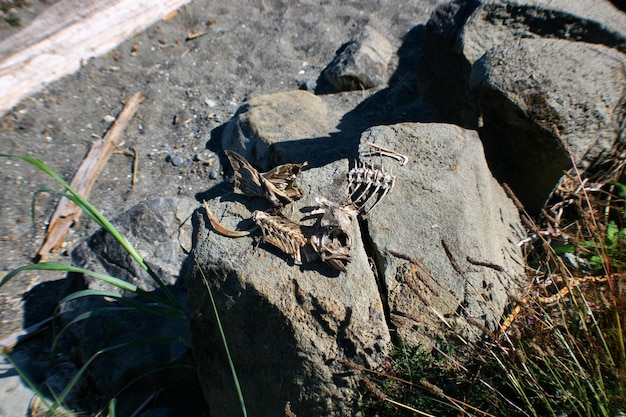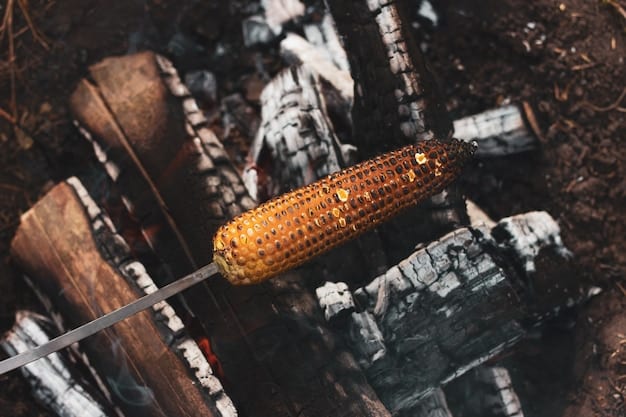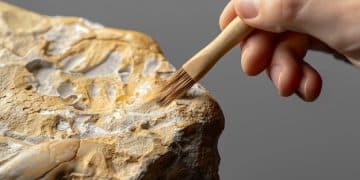Ancient Diets: Unveiling Early American Foodways Through Archaeology

Archaeological evidence, through meticulous analysis of skeletal remains, ancient tools, and food residues, provides invaluable insights into the complex dietary practices and nutritional strategies of early American populations, revealing their intimate relationship with diverse ecological landscapes.
Delving into the dietary habits of ancient civilizations offers a unique window into their lives, technologies, and adaptation to environments. For early American populations, in particular, Analyzing Ancient Diets: What Archaeological Evidence Reveals About the Foodways of Early Americans provides profound insights, painting a vivid picture of resilience and ingenuity. This exploration goes beyond mere caloric intake, touching upon cultural practices, social structures, and ecological comprehension.
The Foundations of Paleo-Dietary Research
Understanding ancient diets isn’t simply about listing what people ate; it’s about reconstructing entire ecosystems and cultural landscapes. Paleo-dietary research, a cornerstone of archaeology, hinges on the meticulous analysis of various forms of physical evidence. This interdisciplinary field combines insights from anthropology, biology, geology, and chemistry to piece together the dietary puzzle of bygone eras.
Early researchers relied heavily on the direct identification of macroscopic plant and animal remains found at archaeological sites. These included charred seeds, desiccated fruits, animal bones with butchery marks, and shellfish middens. Such findings offer undeniable proof of food consumption, but they often represent only a fraction of the actual diet, as many organic materials decompose rapidly.
Pioneering Methods in Dietary Reconstruction
The evolution of archaeological science has brought forth sophisticated techniques, moving beyond simple observation. These methods allow for a more nuanced understanding of dietary patterns, even in the absence of direct food remains. They shed light on what was consumed regularly versus occasionally, and how diet changed over time or varied between social groups.
- Zooarchaeology: Analyzing animal bones to identify species, age, sex, and butchery techniques, providing data on hunting, fishing, and animal husbandry practices.
- Paleoethnobotany: Studying plant remains (seeds, pollen, phytoliths, charred wood) to reconstruct plant use, agricultural practices, and environmental conditions.
- Residue Analysis: Examining residues left on pottery, tools, and grinding stones to identify fats, proteins, starches, and other organic compounds from food.
Beyond these foundational methods, biochemical analyses have revolutionized paleo-dietary studies. Techniques like stable isotope analysis and ancient DNA analysis offer unprecedented precision in determining dietary components, even from human remains. These methods provide a complementary view, confirming or challenging hypotheses derived from macroscopic evidence.
The combination of these diverse methods, from field excavation to laboratory analysis, forms the robust foundation of paleo-dietary research. Each piece of evidence, no matter how small, contributes to a more complete and accurate picture of what early Americans truly ate.
Stable Isotope Analysis: A Chemical Window into Ancient Menus
Stable isotope analysis stands as one of the most transformative techniques in paleo-dietary research. This method examines the ratios of stable isotopes (non-radioactive forms of elements) within human bones and teeth. The principle is elegantly simple: “You are what you eat.” The isotopic signature of a person’s diet is incorporated into their tissues as they grow and metabolize food.
Carbon and nitrogen isotopes are particularly valuable for reconstructing ancient diets. Carbon isotopes (¹³C/¹²C) primarily differentiate between consumers of C3 plants (most trees, shrubs, and cool-season grasses) and C4 plants (tropical grasses like maize and sugarcane). A higher ¹³C value in human remains often indicates a significant reliance on maize, a staple crop for many early American populations.
Unpacking Dietary Diversity with Isotopes
Nitrogen isotopes (¹⁵N/¹⁴N), on the other hand, reveal trophic level – how high an organism is on the food chain. A higher ¹⁵N value suggests a diet rich in animal protein, particularly from aquatic sources or carnivores. The combined analysis of carbon and nitrogen isotopes offers a powerful tool for reconstructing the proportion of different food sources in the diet.
- Carbon Isotopes (¹³C/¹²C): Distinguish between C3 (e.g., wheat, rice, potatoes) and C4 (e.g., maize, a common early American crop) plant consumption.
- Nitrogen Isotopes (¹⁵N/¹⁴N): Indicate the trophic level, differentiating between diets rich in plant protein, terrestrial animal protein, or marine/freshwater protein.
- Strontium Isotopes (⁸⁷Sr/⁸⁶Sr): Can reveal geographical origins and migration patterns, indirectly hinting at local versus imported food sources.
The beauty of stable isotope analysis lies in its ability to reconstruct long-term dietary patterns. While fecal remains or stomach contents offer a snapshot of a single meal, isotopes locked within bone collagen or tooth enamel reflect the diet consumed over several years or even decades. This provides a more representative view of habitual foodways.
However, interpreting isotopic data requires careful consideration of environmental factors that can influence isotopic ratios. Researchers must account for local geology, climate, and the isotopic baseline of the local flora and fauna to accurately interpret human isotopic signatures. Despite these complexities, stable isotope analysis remains an indispensable tool for chemically unraveling the dietary secrets of early Americans.
From Middens to Microscopes: Material Culture as Dietary Clues
Beyond human remains, archaeological sites themselves are treasure troves of dietary information. The material culture left behind by early Americans—from discarded food waste to specialized tools—provides tangible evidence of their food procurement, preparation, and consumption practices. These artifacts offer direct clues that complement biochemical analyses.
Archaeological middens, often erroneously described as mere “trash heaps,” are in fact highly valuable deposits. These refuse piles contain layers of discarded shells, animal bones, plant remains, and broken pottery, meticulously preserving a chronological record of food consumption over generations. Analyzing these layers allows archaeologists to track changes in diet, resource availability, and environmental shifts.
Tools of the Trade: Reflecting Food Processing
The tools early Americans used provide direct evidence of their food processing activities. Grinding stones and metates, for example, indicate the processing of grains, nuts, and seeds. Obsidian or chert projectile points speak to hunting strategies, while bone awls and needles might suggest the processing of animal hides or fibers.
- Pottery: Reveals cooking techniques, food storage methods, and sometimes even residual food traces. The form and decoration of pots can suggest their specific culinary functions.
- Projectile Points: Provide insights into hunting weapons and the types of animals pursued, varying by region and time period.
- Grinding Stones: Evidence of processing plants, particularly grains and nuts, showing a reliance on cultivated or gathered plant foods.
Residue analysis, mentioned earlier, applies micro-scale techniques to these artifacts. Organic residues on pottery shards, for instance, can be analyzed using gas chromatography and mass spectrometry to identify specific lipids, proteins, or starches. This can confirm the presence of certain foods, such as fish oil, maize porridge, or even specific beverages.
While material culture doesn’t provide the same quantitative data as isotopic analysis, it offers invaluable qualitative insights into the practices and choices surrounding food. By combining the “what” from isotopic analysis with the “how” from material culture, archaeologists can construct a much richer narrative of ancient foodways.

The Role of Agriculture and Domestication in Early American Diets
The story of early American diets is inextricably linked to the development and spread of agriculture. While many early populations began as hunter-gatherers, the domestication of plants and animals profoundly reshaped their food systems, leading to more settled lifestyles and significant demographic changes. Maize, beans, and squash—the “Three Sisters” of Mesoamerican agriculture—became foundational crops for numerous societies.
In Mesoamerica, the domestication of teosinte into maize was a monumental achievement, transforming a wild grass into a highly productive staple. This agricultural revolution spread northward into what is now the Southwestern and Southeastern United States, gradually supplementing or even replacing traditional foraging strategies. The widespread adoption of maize cultivation is clearly visible in the isotopic signatures of later populations, which show a strong C4 plant signal.
Impact of Agricultural Innovation
The transition to agriculture was not uniform across the Americas. Some regions, like the Pacific Northwest, continued to rely heavily on abundant wild resources, particularly salmon, while others, like the Great Plains, maintained a strong hunter-gatherer tradition focused on bison. This diversity highlights the adaptive strategies employed by different groups in response to their unique environments.
- Maize (Corn): Gradually adopted across much of the Americas, becoming a primary energy source, especially in Mesoamerica and parts of North America.
- Beans: Provided essential protein, complementing the carbohydrates from maize, and improved soil fertility through nitrogen fixation.
- Squash: Offered varied nutritional benefits and could be stored for long periods, contributing to food security.
Beyond these primary crops, local domestications and cultivations added to dietary diversity. In the Andes, potatoes and quinoa were central. In the Eastern Woodlands, indigenous plants like goosefoot, sumpweed, and sunflowers were early domesticates before the widespread arrival of Mesoamerican crops. Analyzing these subtle shifts in plant use through paleoethnobotany helps trace regional dietary evolutions.
The archaeological record also reveals the social and environmental consequences of agriculture, including increased population densities, communal labor for irrigation, and sometimes, signs of nutritional stress if diets became too narrow. Understanding the interplay between wild resources and domesticated foods is crucial for a complete picture of early American foodways.
Regional Variations: A Mosaic of Dietary Practices
The vast geographical expanse and ecological diversity of the Americas led to a rich mosaic of dietary practices among early populations. There was no single “ancient American diet”; rather, foodways were deeply specific to local environments, cultural traditions, and available resources. Analyzing these regional variations enriches our understanding of human adaptability and ingenuity.
In the frigid Arctic, Inuit and early American groups relied almost exclusively on marine mammals (seals, whales, walruses) and fish, supplemented by caribou. Their diet was rich in fats and proteins, essential for survival in extreme cold. Archaeological sites in these areas are often characterized by massive bone accumulations and specialized hunting tools.
Comparing Dietary Landscapes
Moving south, the Pacific Northwest was a paradise of aquatic resources. Indigenous peoples developed sophisticated technologies for salmon fishing, which formed the cornerstone of their diet. Shellfish, marine mammals, and extensive foraging for berries and roots also played significant roles, leading to a largely non-agricultural, yet sedentary, lifestyle.
- Southwest US: Early adoption of maize agriculture, supplemented by beans, squash, and wild plants like agave and mesquite. Complex irrigation systems were developed.
- Great Plains: Bison hunting was central, often involving communal drives. Plant foods were gathered seasonally, but protein from bison was paramount.
- Eastern Woodlands: Early cultivation of indigenous plants (e.g., sunflowers, sumpweed), later augmented by maize, beans, and squash. Hunting deer and foraging wild nuts were also important.
In the vast woodlands of the Eastern United States, early diets were a blend of hunting deer, turkey, and other game, fishing, and extensive gathering of nuts (acorns, hickory nuts) and wild fruits. Over time, indigenous plant domestication gained prominence, followed by the adoption of maize agriculture, leading to more settled village life.
These distinct regional dietary patterns highlight the intimate relationship between early American societies and their specific environments. Archaeological evidence, ranging from faunal and floral remains to specific tool assemblages, paints a detailed picture of how each group maximized the potential of their unique ecological niche.
Beyond Sustenance: Food, Culture, and Society
Food in ancient societies was far more than mere sustenance; it was intricately woven into the fabric of culture, religion, and social organization. Archaeological evidence extends beyond identifying what was eaten to reveal how food structured daily life, ritual, and power dynamics. The ways in which food was acquired, prepared, shared, and consumed reflect deep cultural values.
Feasting, for example, is evident in many archaeological contexts through the presence of large communal cooking pits, excessive numbers of specific animal bones (e.g., high-status cuts), and specialized serving vessels. These events were crucial for reinforcing social bonds, celebrating important transitions, and displaying status among elites. The distribution of exotic food items or finely crafted serving ware can also indicate trade networks and social hierarchies.
Ritual and Status in Ancient Foodways
Mound-building cultures, such as those of the Mississippian tradition, often reveal evidence of maize-based agricultural intensification, which supported the large populations necessary for monumental construction. Differential access to certain foods, or the consumption of specific foods during ceremonies, can signify social stratification and ritual specialists.
- Burial Offerings: Food remains found in burials suggest beliefs about the afterlife and the symbolic importance of certain foods.
- Feasting Remains: Large quantities of specific food items or unusually high-quality cuts of meat indicate communal gatherings and social celebrations.
- Specialized Ceramics: Pottery forms designed for specific purposes, like effigy vessels or large cooking pots, reflect diverse culinary practices and social events.
The introduction and adoption of new foods, such as maize, also had profound cultural impacts, leading to new agricultural cycles, harvesting rituals, and culinary traditions. Changes in land use associated with farming reflect evolving relationships with the environment and emerging concepts of ownership and territory.
By interpreting the archaeological data with a sensitivity to cultural context, researchers move beyond simple dietary reconstruction to understand the complex interplay between food, environment, and human society. This holistic approach provides a more complete and meaningful narrative of early American foodways.

Future Directions in Dietary Archaeology
The field of dietary archaeology is continuously evolving, driven by technological advancements and increasingly interdisciplinary approaches. New scientific methods are constantly being developed, offering even finer resolution into the nuanced dietary practices of early Americans. These innovations promise to fill many remaining gaps in our understanding.
Ancient DNA (aDNA) analysis, for instance, holds immense potential. By extracting and sequencing DNA from archaeological plant and animal remains, scientists can precisely identify species, understand genetic relationships between domesticated and wild forms, and even detect specific pathogens related to foodborne illnesses. Similarly, aDNA from human remains can reveal genetic adaptations to specific diets.
Emerging Technologies and Holistic Approaches
Proteomics, the study of proteins, is another frontier. Proteins preserved in dental calculus (plaque) or bone can directly reveal what an individual ate, including specific animal or plant species, allergens, and even the presence of fermented foods. This offers a different, complementary line of evidence to isotopic analysis.
- Metabolomics: Analyzing small molecule metabolites in archaeological samples to identify dietary components and metabolic responses.
- Non-Destructive Imaging: Techniques like micro-CT scanning and X-ray fluorescence (XRF) allow for detailed analysis of artifacts and bones without causing damage.
- Environmental Reconstruction: Advanced modeling and environmental DNA (eDNA) analysis provide a more accurate picture of ancient landscapes and resource availability.
Furthermore, climate modeling and paleoenvironmental reconstructions are becoming increasingly sophisticated, allowing archaeologists to better understand how environmental shifts influenced human subsistence strategies. This holistic approach integrates archaeological data with environmental science to illuminate the dynamic interplay between people and their surroundings.
As these new techniques mature and become more widely accessible, dietary archaeology will continue to refine our narratives of early American foodways. The future promises an even more detailed, nuanced, and accurate understanding of how ancient populations fed themselves, adapted to their environments, and built their cultures around the fundamental act of eating.
| Key Point | Brief Description |
|---|---|
| 🔬 Isotopic Analysis | Chemical analysis of bones and teeth reveals long-term dietary patterns (e.g., C3 vs. C4 plants, meat vs. plants, marine vs. terrestrial). |
| 🏺 Material Evidence | Middens, tools (grinding stones, projectile points), and pottery residues offer direct proof of food procurement and preparation. |
| 🌽 Agricultural Shift | Domestication of maize, beans, and squash dramatically transformed diets and led to settled lifestyles in many regions. |
| 🌎 Regional Diversity | Diets varied significantly based on local ecosystems (e.g., marine focus in Arctic, bison on Plains, agricultural in Southwest). |
Frequently Asked Questions About Ancient American Diets
Archaeologists rely on various sources: human skeletal remains (especially stable isotopes in bones/teeth), animal bones (zooarchaeology), plant remains (paleoethnobotany), food residues on pottery and tools, and ancient human fecal matter. Each provides different insights into diet composition and preparation techniques over time.
The domestication and widespread adoption of maize (corn) provided a highly reliable and caloric food source. This led to increased population density, more sedentary lifestyles, the development of complex social structures, and new agricultural technologies across many regions, especially in the Southwest and Eastern Woodlands.
No, dietary practices varied greatly by region. While agriculture was significant in many areas, groups like those in the Pacific Northwest relied heavily on abundant wild resources, such as salmon. Similarly, Plains Indians maintained a strong hunter-gatherer tradition focused on bison, adapting to their native environments.
Stable isotope analysis examines the ratios of non-radioactive elements (like carbon and nitrogen) in human bones and teeth. It reveals long-term dietary patterns, such as the proportion of C3 versus C4 plants (e.g., maize), and the consumption level of animal protein, distinguishing between terrestrial and marine sources.
Food was central to ancient American societies, influencing social structure, rituals, and technology. Evidence of feasting, food offerings in burials, and specialized storage or serving vessels reveal communal practices, status differentiation, and spiritual beliefs tied to diet and resource management.
Conclusion
The archaeological evidence concerning the foodways of early Americans paints a picture of incredible diversity, adaptability, and ingenuity. From the earliest hunter-gatherers to the sophisticated agricultural societies, each group devised unique strategies to thrive within their ecological niches. Tools, bones, botanical remains, and the remarkable insights gleaned from stable isotope analysis collectively illuminate not just what people ate, but how their diets shaped their societies, cultures, and relationship with the land. This ongoing research continues to unveil the complex stories embedded in every ancient meal, pushing the boundaries of our understanding of human history and resilience.





